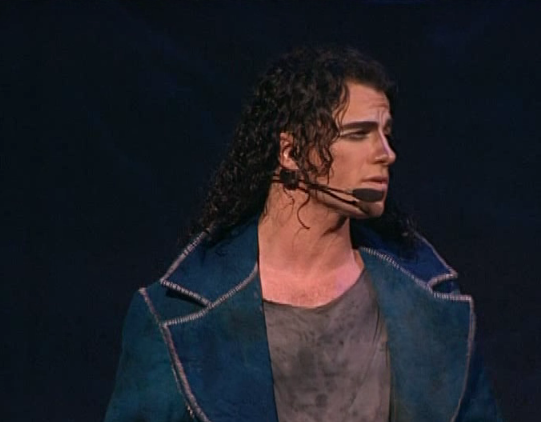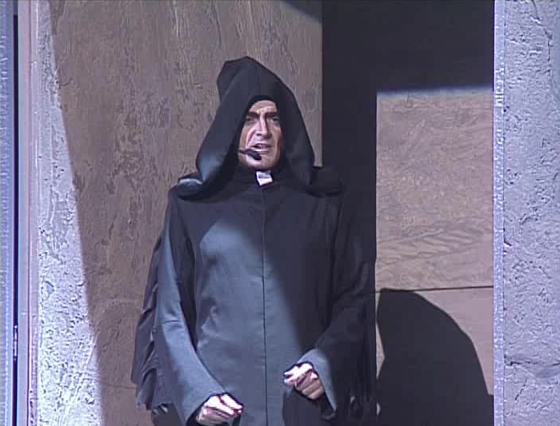I might discuss aspects from other casts but I’m going to keep it to the original cast.
Le Temps des Cathédrals (The Age of Cathedral)
This is the first number of the show. It’s sung by Pierre Gringoire who acts mainly as a story teller. The song tells us about the changing times and how teh Cathedral once prominent and important to society is falling away and that population is changing too as people seek refuge in Paris.
The song itself is very mysterious with a touch of bittersweetness. The songs also have a great build and there is a nice reveals of the stage as the song builds. It starts with a bare stage and Gringoire but slowly layers of screens are pulled back to reveal the set pieces.
Le temps des cathédrales is also a great showcase for Gringoire’s voice. Bruno Pelleteir has such an expressive voice. Also with all the power and build up and the enegry Gringoire to into the song it transition to the nest song very nicely.
Les Sans Papiers (Those without Papers)
Just a little clarication papers meaning without passport, or without legal documentation which I don’t think they would have had in 1482, could be wrong but it a big deal these days and the Refugee were a big issue in France at the time this musical came out so it’s topical.
So what is interesting about Notre Dame de Paris is that even though they didn’t start it the same way as the book they do introduce the characters at roughly the same points. This songs in Clopin asking for refuge for his people. There is also the same tone of change.
There is a great power and darkness to Le Sans Papiers. It’s interesting that a song that is basically begging would have such a forceful tone to it. There is also a menace and urgency that makes this song exciting by the end.
It also the first number with dancing. Notre Dame de Paris has a lot of dancing. For this particularly number the dancing is a little weird. I don’t know a ton or anything about dance, heck I was run out of tap dance class at the age of six, I’m the last person who should critic dance but while I think the dancing in this number is effective to the tone and mood of the song I don’t care for it. Some of it look like spazing out, which I excel out. I did like that walk out and throw down move.
Also during this song you can see Frollo looming in Notre Dame, as played by a rock climbing wall. And as indicated by the next song, this song did not melt Mr. Frollo’s icy heart.
Intervention de Frollo (Intervention of Frollo)
This is the first song that is a little different between the cast version. Frollo commands Phoebus to arrest the people and he complies. In the original cast he tries to arrest Esmeralda and is taken with her. In other versions, after getting the order Phoebus finds Esmeralda dancing and is taken. It’s both a HUGE difference and not. With her dancing it clarifies Esmeralda as a dancer but the transition is not smooth. With the arrest we lose her a bit as dancer but it makes for a better transition. Though it’s a transition that exist within the song.
As bridge song, Intervention de Frollo is okay. It’s very staccato but gets the point across of Frollo authority and coldness and Phoebus‘ conformity and interest in pretty girls.
*I might translate these with crummy translations or go by the English titles. which can also be crummy.
GET THE WHOLE GLORIOUS ALBUM



